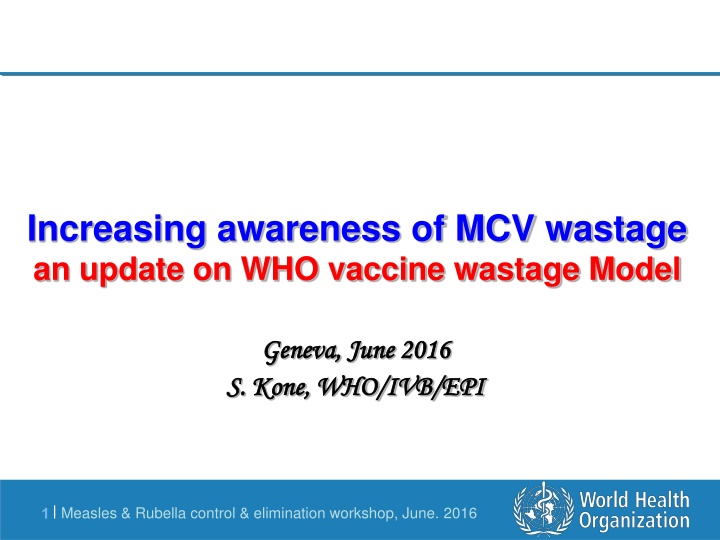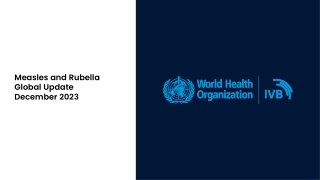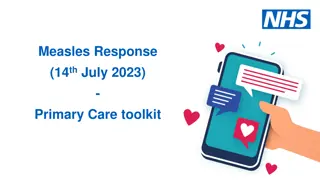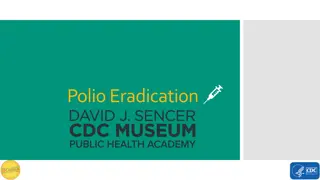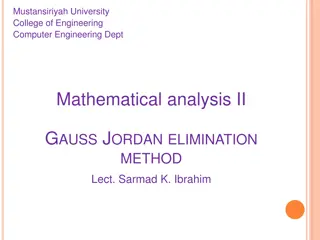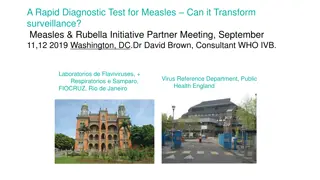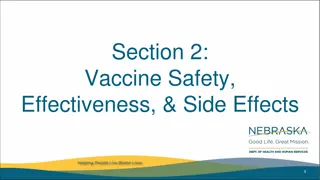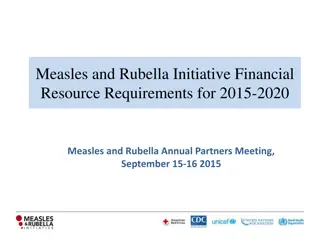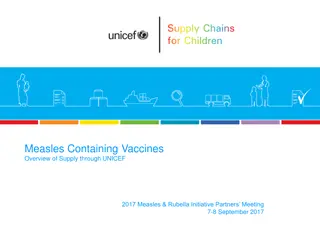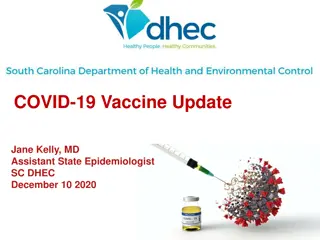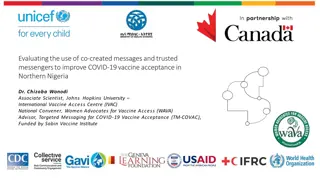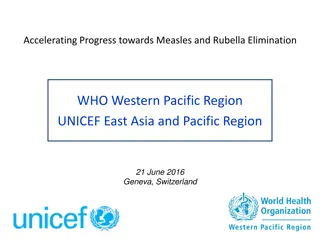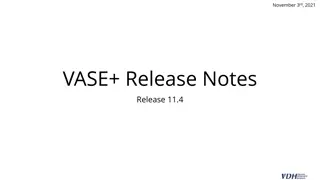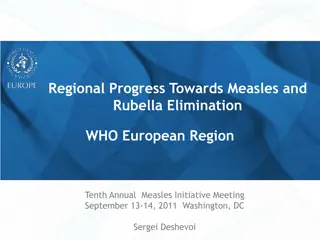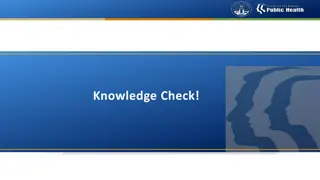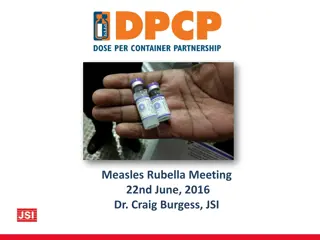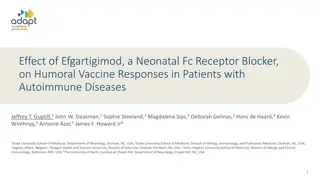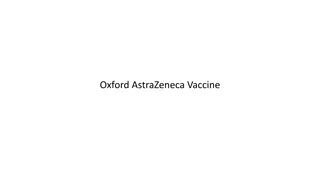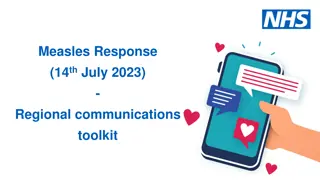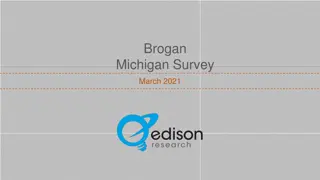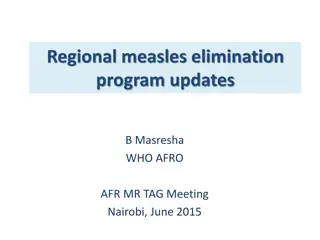The Impact of Vaccine Wastage on Measles Elimination Efforts
This presentation focuses on the significance of vaccine wastage in the context of measles elimination, emphasizing the factors influencing wastage, why it matters for achieving high vaccination coverage, and tools for estimating wastage. The content highlights the challenges posed by wastage on vaccine supply, infrastructure capacity, sustainability, and public trust in vaccines and health services. Additionally, it addresses the specific implications of wastage on measles elimination programs, such as the importance of minimizing stock-outs and missed opportunities for vaccination.
Download Presentation

Please find below an Image/Link to download the presentation.
The content on the website is provided AS IS for your information and personal use only. It may not be sold, licensed, or shared on other websites without obtaining consent from the author.If you encounter any issues during the download, it is possible that the publisher has removed the file from their server.
You are allowed to download the files provided on this website for personal or commercial use, subject to the condition that they are used lawfully. All files are the property of their respective owners.
The content on the website is provided AS IS for your information and personal use only. It may not be sold, licensed, or shared on other websites without obtaining consent from the author.
E N D
Presentation Transcript
Increasing awareness of MCV wastage an update on WHO vaccine wastage Model Geneva, June Geneva, June 2016 S. Kone, WHO/IVB/EPI S. Kone, WHO/IVB/EPI 2016 1|Measles & Rubella control & elimination workshop, June. 2016
Purpose of this Presentation 1. Review factors influencing vaccine wastage 2. Highlight why this is relevant to measles elimination 3. Tell you about two tools on estimating vaccine wastage (Model and Mobile Application) 2|Measles & Rubella control & elimination workshop, June. 2016
Why vaccine wastage matters? Vaccine supply Impacts exponentially supply Inflates capacity of infrastructures Challenges sustainability Loss of investment Alliterates donors trust Coverage & equity targets High potential impact on service delivery (stock-outs, miss-opportunities) Loss of public confidence in vaccines & health services AEFI & false sense of protection 3|Measles & Rubella control & elimination workshop, June. 2016
Why vaccine wastage matters to Measles Elimination? 1. 2. 3. Nearly all countries use 10dv Can t use MDVP Only 1 or 2 dose schedule (means lower number of doses administered per session compared to many other vaccines) Need very high coverage to eliminate measles; can t afford stock-outs or missed opportunities Measles second dose assessments and outbreak investigation have revealed that HCW may be reluctant to open 10dv because of fear of running out of vaccine or fear of wastage. 4. 5. 4|Measles & Rubella control & elimination workshop, June. 2016
How do we estimate vaccine wastage? Supply chain structure Number of levels EVM limits Type of wastage Unopened/closed vial Opened (multi-dose) vial Service delivery pattern Session size (#doses administered) Frequency (how often) WHO vaccine wastage Model (under IPAC) Closed vial wastage, based on supply chain levels and EVM maxi limits Opened (multi-dose) vial, based on vial presentation, status of MDVP and session size and frequency Handling & administration conditions of opened vial during and after session 5|Measles & Rubella control & elimination workshop, June. 2016
WHO vaccine wastage model Binomial distribution of no. of doses administered per session based on: Size of target population Frequency of session No. of doses per target Doses of vials opened to be discarded at end of session depends on: Vial size Status of MDVP WHO indicative wastage defined as: Product of binomial distribution by wastage 6|Measles & Rubella control & elimination workshop, June. 2016 Factor of no. levels in supply
The use of the model Assessing impacts of policy settings (selecting vaccines) and organizing services (frequency of sessions), Matching expectations with policies Policy setting Accurately forecasting vaccine needs Defining safety stocks to avoid stock outs Supplying adequate quantities in supply chain Adequacy of supply Assessing organization and implementation of services according to the policy Monitoring services and consistency of data Ensuring quality of data Service delivery 7|Measles & Rubella control & elimination workshop, June. 2016
Mobile Application background 1. A Mobile Application is currently under development 2. The Application is designed to be used by district managers to facilitate supportive supervision related to vaccine supply, wastage, and practices. 3. HF-specific information is input and provides an estimate of expected wastage in that HF. This may help the supervisor and HCW understand for example: How much wastage is expected in given HF If enough safety stock has been given to vaccinate according to policy If wastage is lower than expected, the supervisor may inquire about vaccination practices and reassure HCW to vaccinate according to policy (or increase safety stock if needed). If wastage too high, investigate factors (volume is lower than expected), may need to adjust session frequency (according to national guidance). 8|Measles & Rubella control & elimination workshop, June. 2016
Demo wastage mobile application 9|Measles & Rubella control & elimination workshop, June. 2016
10|Measles & Rubella control & elimination workshop, June. 2016
11|Measles & Rubella control & elimination workshop, June. 2016
Next Steps for Mobile Application 1. Complete the design and programming of the Application 2. Carefully pilot to ensure the application will promote national policies and support providing safety stock needed to implement policy. Pilot country must have clear policies related to vaccine supply/safety stocks, wastage, vaccination policy (how many children present before opening a vial) Clear guidance must be developed on how to use the Application, what additional information may be needed (ie, closed vial wastage?), what advice should be given under different scenarios Determine if application adds-value in terms of increasing knowledge of supervisor and HCW, facilitating sufficient supply of safety stocks, promoting vaccination practices in-line with national policy. 12|Measles & Rubella control & elimination workshop, June. 2016
Thank you! 13|Measles & Rubella control & elimination workshop, June. 2016
